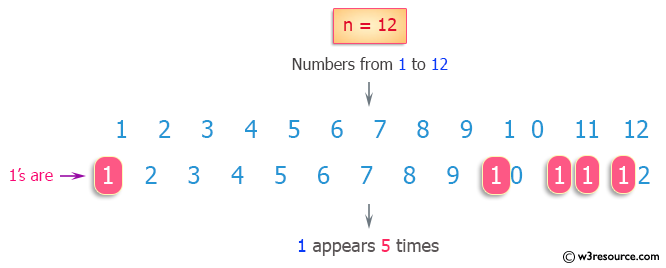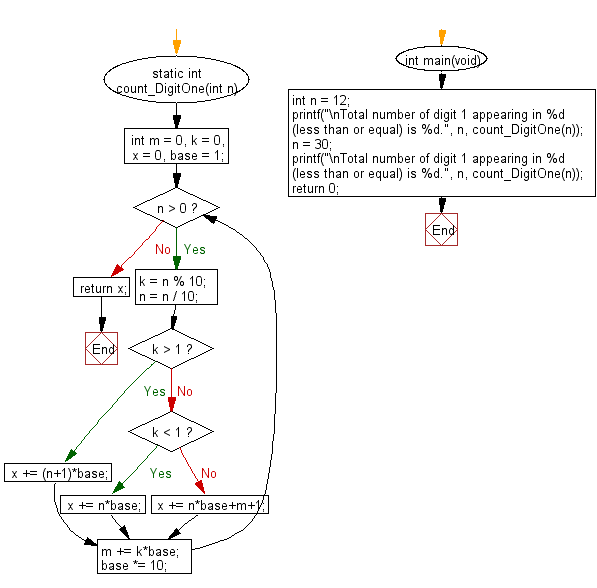C Exercises: Count the total number of digit 1 appearing in all positive integers less than or equal to a given integer n
C Programming Mathematics: Exercise-11 with Solution
Write a C program to count the total number of digit 1 appearing in all positive integers less than or equal to a given integer n.
For example:
Input n = 12,
Return 5, because digit 1 occurred 5 times in the following numbers: 1, 10, 11, 12.
Example:
Input:
n = 12
n = 30
Output:
Total number of digit 1 appearing in 12 (less than or equal) is 5.
Total number of digit 1 appearing in 30 (less than or equal) is 13.
Pictorial Presentation:

Sample Solution:
C Code:
#include <stdio.h>
static int count_DigitOne(int n) {
int m = 0, k = 0, x = 0, base = 1;
while (n > 0) {
k = n % 10;
n = n / 10;
if (k > 1) { x += (n+1)*base; }
else if (k < 1) { x += n*base; }
else { x += n*base+m+1; }
m += k*base;
base *= 10;
}
return x;
}
int main(void)
{
int n = 12;
printf("\nTotal number of digit 1 appearing in %d (less than or equal) is %d.", n, count_DigitOne(n));
n = 30;
printf("\nTotal number of digit 1 appearing in %d (less than or equal) is %d.", n, count_DigitOne(n));
return 0;
}
Sample Output:
Total number of digit 1 appearing in 12 (less than or equal) is 5. Total number of digit 1 appearing in 30 (less than or equal) is 13.
Flowchart:

C Programming Code Editor:
Improve this sample solution and post your code through Disqus.
Previous: Write a C program to find the number of trailing zeroes in a given factorial.
Next: Write a C programming to add repeatedly all digits of a given non-negative number until the result has only one digit.
What is the difficulty level of this exercise?
Test your Programming skills with w3resource's quiz.
C Programming: Tips of the Day
Static variable inside of a function in C
The scope of variable is where the variable name can be seen. Here, x is visible only inside function foo().
The lifetime of a variable is the period over which it exists. If x were defined without the keyword static, the lifetime would be from the entry into foo() to the return from foo(); so it would be re-initialized to 5 on every call.
The keyword static acts to extend the lifetime of a variable to the lifetime of the programme; e.g. initialization occurs once and once only and then the variable retains its value - whatever it has come to be - over all future calls to foo().
Ref : https://bit.ly/3fOq7XP
- New Content published on w3resource:
- HTML-CSS Practical: Exercises, Practice, Solution
- Java Regular Expression: Exercises, Practice, Solution
- Scala Programming Exercises, Practice, Solution
- Python Itertools exercises
- Python Numpy exercises
- Python GeoPy Package exercises
- Python Pandas exercises
- Python nltk exercises
- Python BeautifulSoup exercises
- Form Template
- Composer - PHP Package Manager
- PHPUnit - PHP Testing
- Laravel - PHP Framework
- Angular - JavaScript Framework
- Vue - JavaScript Framework
- Jest - JavaScript Testing Framework
